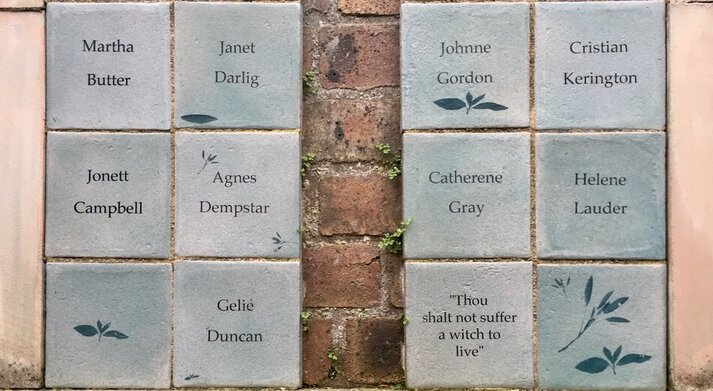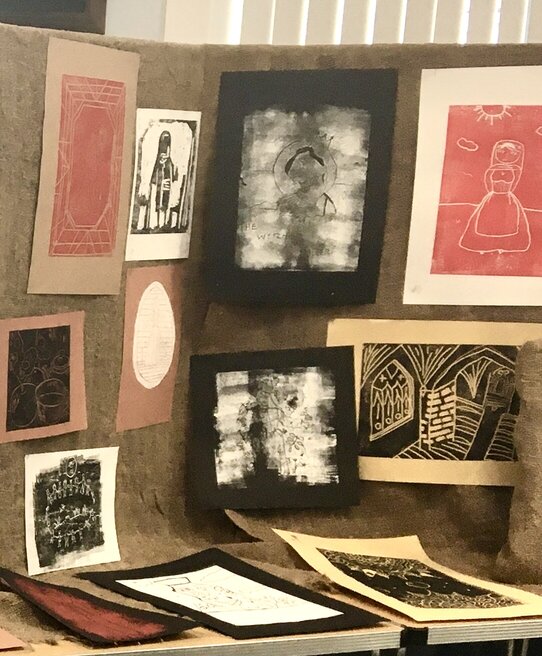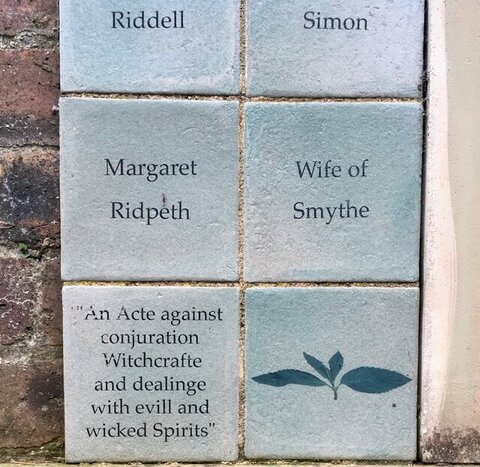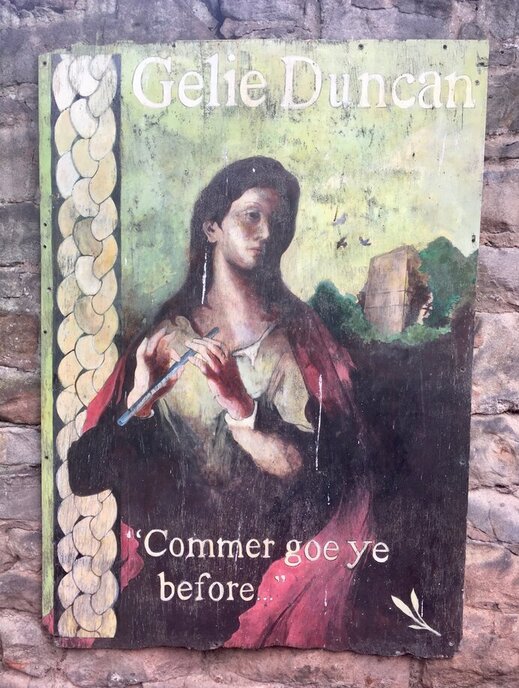“Ashes and Stones: A Scottish Journey in Search of Witches and Witness” by Allyson Shaw

Book review by Priestess Elan
The Cerridwen Kindred are familiar with the idea of ‘witches’ walks’ – we have journeyed physically (in Glastonbury) and virtually (with online ceremonies) to honour those accused of witchcraft during the historical witch trials. So, when Ashes and Stones: A Scottish Journey in Search of Witches and Witness by Allyson Shaw was published last month, it felt like the perfect book to continue my Cerridwen ‘witch’ work. After all, this is an ongoing process, as we uncover and heal more of the witch wound in our personal and wider community landscapes.
Shaw’s book did not disappoint. In fact, there were times when I felt that we were having a two-way conversation as I read the book. It has been comforting to realise the extent to which so many of those who are honouring the women who suffered and were killed in the witch trials are connected in belief and intuition.

Photograph by Gail Spiritstar at the Witches’ Memorial at the Prestoungrange Gothenburg Tavern, Prestonpans, East Lothian, Scotland
Allyson Shaw is herself a witch and, while she now lives in Scotland, she is an American by birth. Woven throughout Ashes and Stones is her own personal healing journey and this feels apt. After all, so many of us are drawn to the witch trials through our own personal journeys and shadow work.
From the outset, Shaw is honest about her search for rootedness and belonging, and it is especially poignant that she finds this sense of belonging among the Scottish women tried and executed for witchcraft. She writes “I consider adopting ancestors who were unclaimed, unloved and forsaken – the women ostracised by their communities and accused as witches. I would claim them as my own.”
Shaw has beautifully honoured these ‘claimed ancestors’ in her book. Spanning nineteen chapters, she journeys throughout Scotland, visiting memorial stones and other evidence of the witch-hunts on the landscape – perhaps most chilling is the evidence of witches’ rings, still visible today in Scottish churches, where people were chained to the walls. As well as the physical journeys, she travels through the Scottish trial records and church records, tracing the lives of the accused women (this in itself feels like a rebel act – as a researcher without an academic affiliation, Shaw came up against a few brick walls, but she persevered).
Shaw’s research took place over many years and it is clear that she really got to know each woman she researched. I sincerely hope that this will not be her last book or project on the ‘Scottish witches’.
I came to this book with my own knowledge of the Scottish witch trials and the mark that this has left upon my country and yet, Shaw has made me think even more deeply on this subject. She highlights the fact that many of the memorials and information plaques are inaccurate and/or follow an established, well-worn line, which is less than honourable to the people they are supposed to remember. She is also rightly scathing of the way ‘witches’ are used by the Scottish tourist industry.
Highlighting the accusers
Crucially, Shaw takes time to discuss the accusers as well as the accused. It is this aspect of the book, which has had the greatest personal impact on me. So much work is being carried out in Scotland at present to discuss the stories of the accused women, but Shaw goes further than this, picking apart the misogynistic system and the individuals who condemned these women. It makes for grim, sad, but necessary reading – in Scotland, it is perhaps time to face up to the fact that not only are we descended from those who were accused of witchcraft, we also carry with us the legacy of those who tried these ‘witches’.
One part of the book has continued to haunt me long after I finished it (and interestingly, it is the seemingly small asides which have had the most powerful effect on me); Shaw points out that many of the women were accused by their own parish ministers. Coming from a Church of Scotland background, I felt the full force of this realisation and the implications of the broken trust that must have taken place and which goes hand-in-hand with this factual detail.
Scottish religious history, particularly Reformation history, is bound up with the witch trials, and I now fully understand the need for the apology which was given at the General Assembly of the Church of Scotland in 2022.

Image of school children’s artwork inspired by workshops run by the Calder Witch Hunt, photograph taken by Gail Spiritstar at their July 2022 exhibition in West Calder, West Lothian, Scotland
I have never read a book about the Scottish witch trials quite like Ashes and Stones. Allyson Shaw asks the question “What have we lost, and what ghosts do we live with now?”. It is books such as this one, which will help us to answer these questions and to understand how the past affects our present, no matter where in the world we come from.
Reflections on Ashes & Stones by Priestess Gail Spiritstar
Introduction
“Magic, power, fighting back against an oppressive patriarchy… witchlit is having a moment” asserts Francesca Brown in The Stylist [1]. The past few years have seen increased interest in and scrutiny of historical deeds and misdeeds, the process of reviewing the past informing the debate about shaping the future. The lid has been lifted off thorny and uncomfortable subjects, such as British participation in and profit from the slave trade.
In Scotland one topic being re-visited is that of the historical persecution of the vulnerable, mainly women, following the laying of the 1563 Witchcraft Act. Around 4000 people were known to have been accused of Witchcraft in Scotland from the late 16th to the 18th Centuries with a (conservative) estimate of 2,500 executed [2]. This was about four times the European average [3]. 84% of the accused in Scotland are known to have been women, 14% men and 1% with no gender recorded [4].
Interest has been intensified by recent work by organisations such as Remembering the Accused Witches of Scotland [5] and campaigns such as that of The Witches of Scotland [6]. They (WoS) were seeking a retrospective apology for all those accused and convicted of witchcraft (delivered by Scotland’s First Minister, Nicola Sturgeon, on International Women’s Day 2022 [7]). They also want a pardon for those convicted of witchcraft (the Scottish Government held a consultation and Natalie Don, Member of the Scottish Parliament, is progressing a proposed Members Bill in relation to the pardon [8]). Lastly, they are calling for a national memorial to respect the memory of those accused and convicted of witchcraft.
Alongside the political and legal movements, there is a burgeoning creative response to this exploration of the historical witchcraft persecutions; music, artwork, theatrical productions, films and a proliferation of witch-related writing. 2023 promises the publication of many more fiction and non-fiction books on the subject. Why? Francesca Brown explains:
“protagonists are often…women who face oppression, violence, misogyny, erasement and suspicion, as well as those who are marginalised by their sexuality or their refusal to conform to the traditional gender roles assigned to them; if anything resonates in our lives in 2023, it’s this.” (The Stylist)
Silencing women and the struggle for authentic voices
Ashes & Stones: A Scottish Journey in Search of Witches and Witness by Allyson Shaw is an intriguing mixture of historical research, travel writing and auto-biographical introspection. I have seldom read a book which instantly felt so deeply familiar. I have also spent recent years immersing myself in the written records, exploring the landscape, uncovering the stories and seeking to remember and honour those who suffered through the historic witchcraft persecutions.
My brother gave me Ashes & Stones as a birthday present and I started it eagerly. However, as a native Scot, I am ashamed to admit my hackles initially rose when I realised the author was born in the United States of America. I feel so passionately about this subject and the need to be part of lancing a festering National wound. One of the main functions of the historic witchcraft persecutions was to silence women’s voices. I felt panic rising in me – even in this time of remembrance and reflection, was the voice of Scottish women still not to be heard telling our own stories?
However, fortunately, Allyson Shaw is no Raymond Buckland, whose book Scottish Witchcraft and Magick: The Craft of the Picts [9] infuriated me. Allyson has spent years doing her own research, exploring the landscape, examining trial records looking for any glimpse of Scottish women’s authentic voices. This is, of course, fraught with difficulties. The records were written by men, who were part of power structures and institutions such as the Kirk or the judiciary. Records were made to prove the guilt of the accused. Scribes recorded what suited the authorities, in some cases even omitting women’s names (see “Wife of Smythe” in the photograph below).

Photograph by Gail Spiritstar at the Witches’ Memorial at the Prestoungrange Gothenburg Tavern, Prestonpans, East Lothian, Scotland
I watched a fascinating interview with Allyson Shaw, conducted by Alistair Braidwood on his “Scots Whay Hae!” podcast [10]. Allyson, who herself identifies as a neo-pagan witch, questions the extent to which one can ever forget the context of suffering and torture when looking for traces of forgotten beliefs or practices. She asks “can we look back at that lore or is it opportunistic? There are lots of ethical questions when mining this history for meaning”.
During Allyson’s research she also came across “secret” messages from Scottish people intended for each other. People in different centuries recorded what they knew of the history of the atrocities, so future generations could learn and improve.
The process of writing during the Coronavirus pandemic
In the interview, Alistair asks Allyson whether writing in lockdown led her to explore personal reflections. She responded that yes, the time spent in isolation, not seeing anyone, encouraged introspection. Sitting alone with your past became a “really immediate reckoning, in that space of the pandemic”.
Allyson had begun her book as a travelogue. This changed as she became more and more deeply immersed in historical research. Then Allyson’s father died. She was struggling with her own health. She found herself wrestling with themes of dehumanising forces such as “otherness”, misogyny, the pathologisation of illness. Allyson explained that as a woman who has herself survived misogynistic violence, she has empathy with the reality of being on the run, of being hunted. The personal seemed to be intensely relevant to a book about mourning, misogyny and outsiderness, a way for her to speak up against the dehumanising forces.
Ashes & Stones enables us to look at the present, through the lens of the past. In the podcast interview, Allyson says that sadly, the scapegoating of the most vulnerable in society, those in power deflecting the woes of the larger culture on the most powerless, is still happening right now.

Photograph by Gail Spiritstar at the Witches’ Memorial at the Prestoungrange Gothenburg Tavern, Prestonpans, East Lothian, Scotland
Witches, witness and women walking…
The subtitle of the book is “A Scottish Journey in search of witches and witness”. Witness is a central theme to the book; acknowledgement, remembrance, giving voice to those who were silenced by persecution, execution or simply fear.
Allyson explains to Alistair that her encounters with people, as she travelled the length and breadth of Scotland, were somewhat surprising to her. Some people told her sensationalised versions of tales, which she found distasteful and at odds with her historical research. Many locals simply did not know about the history of the witchcraft persecutions in their locality. As someone who has gone through primary and secondary education in Scotland, I can attest to the fact we didn’t learn much about Scottish history at all (except for 17th Century crop rotation!), let alone the history of the Witchcraft Acts and how the persecution has impacted on Scottish people and communities down the generations.
Allyson visited some sites multiple times, over time, and was pleased to observe some improvements, changes or just signs of care. Some of the memorials, such as the collaboration in Kirkwall in Orkney between archivists, writers, musicians and a potter, symbolise an “outpouring of creative energy that sought to humanise the women”. These community endeavours perhaps have more meaning and come from a more genuine place of respect and honouring than a national heritage memorial aimed at the tourism trade and revenue generation. Communities coming together and owning the narrative of their own places.
As Allyson travelled the countryside, she occasionally found humble offerings; a flower here, a ‘hag’ stone there, a piece of beach glass smoothed by the sea, an arrangement of leaves on a mossy stone. Allyson had the growing sense of being one among a number of people quietly visiting these forgotten places in remembrance.
In both book and podcast, Allyson highlights the tension inherent in the new wave of interest of the last few years. On the one hand, there is the drive to dignify the memory of the persecuted, to honour them and to respectfully learn the lessons from our past to improve our collective future. On the other, there is the lure of making money, using this latest witch-craze as a “cash-cow” and the fetishisation of implements and places of torture and the methods and moments of execution. Allyson says to Alistair that she would dearly like to see an end to this “indulging in the pyre”.
What is next for Allyson? The North American edition of Ashes & Stones will be published by Pegasus Books on the 3rd of October, 2023. In the video interview with Alistair, Allyson is very clear that the list of women she included in her book is far from exhaustive. Even as it was being published, she was still discovering more memorials and carlin stones. She said this feels like just the beginning of her journey. Allyson is considering delving more deeply into the history of Orkney and Shetland next.
Ashes & Stones is a thoughtful, multi-layered book, complex and compelling. Throughout its pages I hear the call for community. As women, we walk the same paths. We may travel down them at different times and different paces. Sometimes we may walk a long way on our own. Yet, eventually, our paths will intersect. As Priestesses of Cerridwen we hold our in-person and Virtual Witches’ Walks annually. It is comforting to know that sisters like Allyson are out there walking too.
References
1. https://www.stylist.co.uk/books/the-biggest-book-trend-for-2023-why-witchlit-is-hitting-a-nerve-right-now/756874 accessed 17/03/2023
2. Goodare, Julian. “Women and the Witch-Hunt in Scotland.” Social History 23, no. 3 (1998): 288–308. http://www.jstor.org/stable/4286516.
3. Goodare, Julian. “Witch-hunts”, in M. Lynch, ed., The Oxford Companion to Scottish History (Oxford: Oxford University Press, 2001), pp. 644–5
4. University of Edinburgh, “The Survey of Scottish Witchcraft”, https://www.shca.ed.ac.uk/Research/witches/introduction.html accessed 17/03/2023
5. https://www.raws.scot/ accessed 17/03/2023
6. https://www.witchesofscotland.com/ accessed 17/03/2023
7. https://www.bbc.co.uk/news/uk-scotland-scotland-politics-60667533 accessed 17/03/2023
8. https://www.parliament.scot/get-involved/petitions/view-petitions/pe1855-pardon-and-memorialise-those-convicted-under-the-witchcraft-act-1563 accessed 17/03/2023
9. Buckland, Raymond, Scottish Witchcraft and Magick: The Craft of the Picts, Llewelyn Publications, 1991
10. https://youtu.be/Fo8w1oEj7-8 “Scots Whay Hae!” podcast, accessed 16/03/2023
‘Ashes and Stones’ can be bought in bookshops and online stores such as abebooks.co.uk
Elan, Priestess of Cerridwen
West Lothian, Scotland

Instagram: @elan_and_the_hare
Elan is a scholar, writer and editor in the field of Celtic Studies. She has a PhD in Gaelic poetry and teaches university classes in Celtic culture and literature.
Gail Spiritstar Roberts, Priestess of Cerridwen
Gwynedd, Wales

Gail Spiritstar is a Priestess of Cerridwen and an Awenydd of the Anglesey Druid Order. Born in Edinburgh, Scotland, Gail has always known in her bones the essential, deep connection with nature and a love of wild places. She has been consciously following a path of nature-based spirituality for 35 years. Gail moved to Wales in 1995 to train with the Welsh College of Music and Drama in Cardiff. She is an experienced actor, singer and storyteller. Gail now lives in Southern Snowdonia, not far from Llyn Tegid, Bala. As a Priestess she enjoys serving by co-creating ceremonies, building community and…anything else Cerridwen may require!
Wow! Elan, this is such a great read. I have ordered this book to delve into it and learn more about this topic. Since you introduced me to the witches walk a few years ago, I’m more curious to learn about these women that were falsely accused and the history as well. Such an incredibly emotional topic. Thank you for including the YouTube video of the author as well. I’m fascinated.